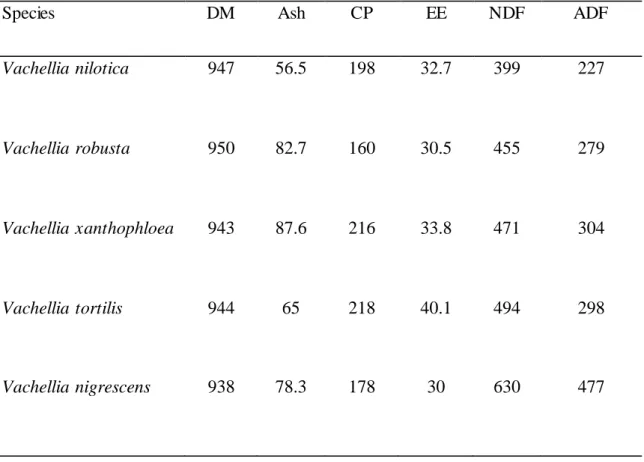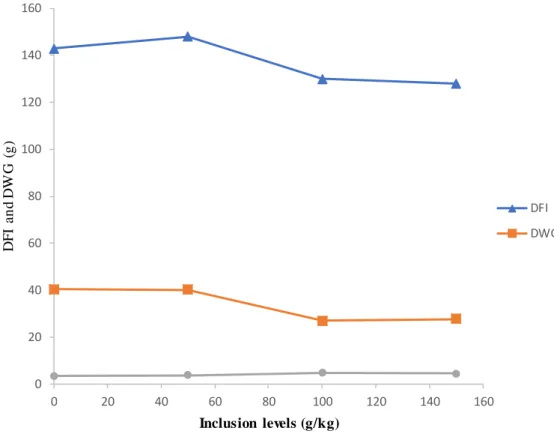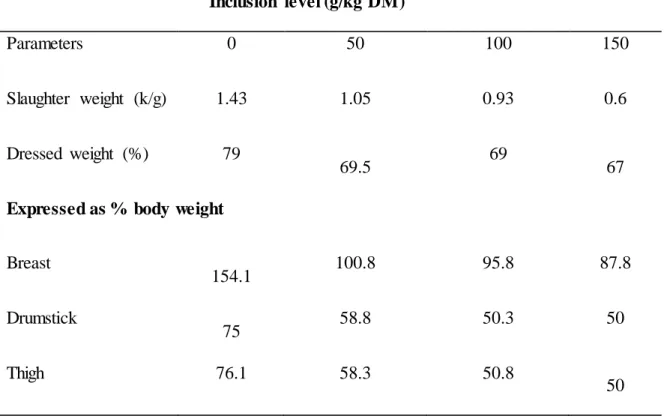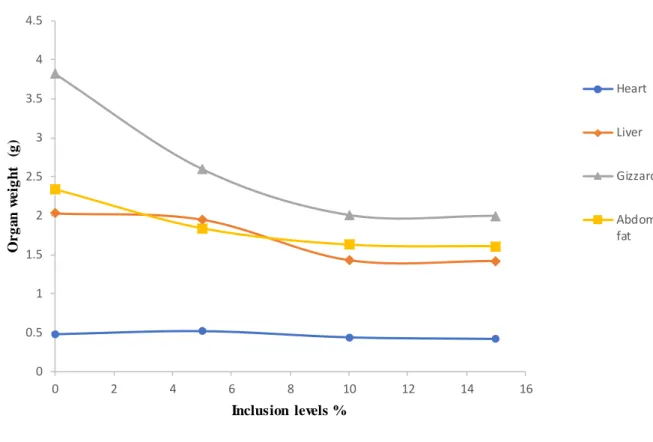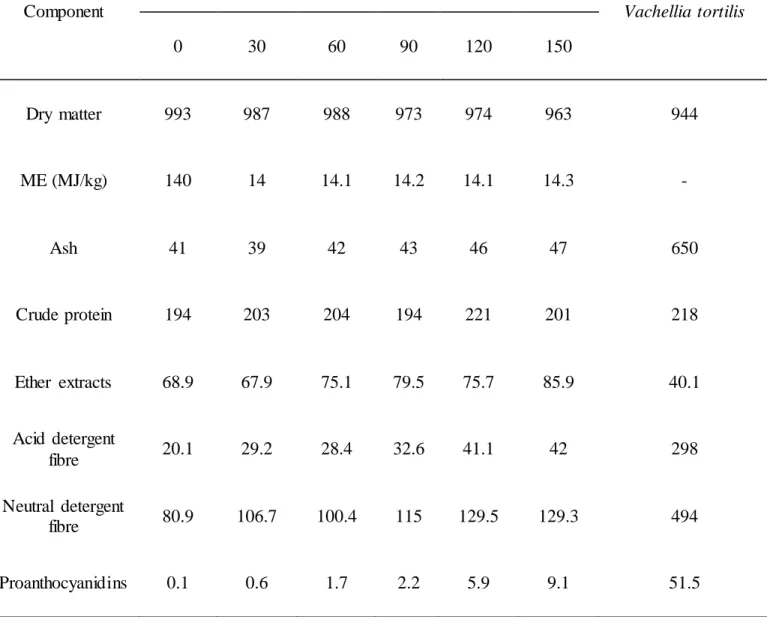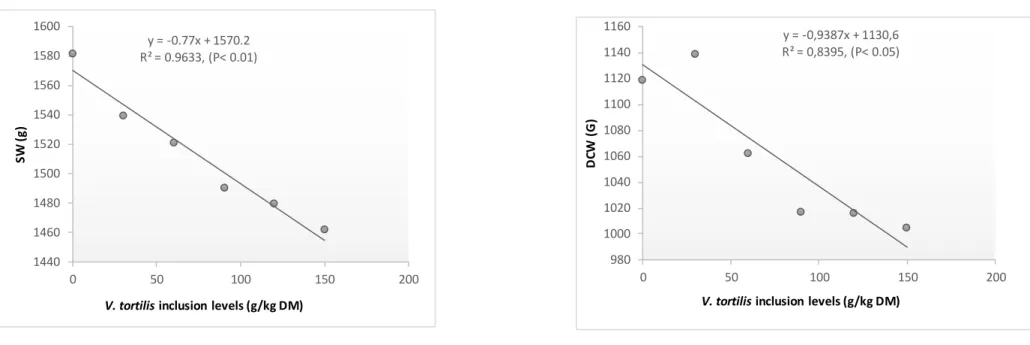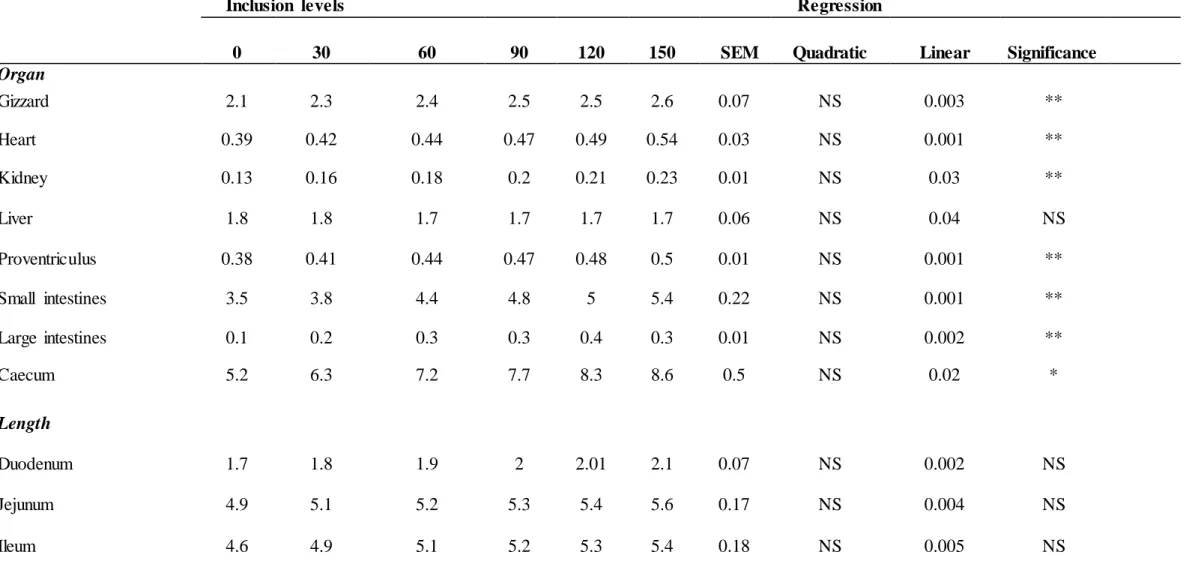However, the weight of the stomach, intestine and stomach increased linearly (P<0.05) as the leaf meal content increased. Submucosa, muscle tissue, and epithelium thickness, however, increased linearly (P <0.05) as leaf meal levels increased.
General introduction
- Background
- Justification
- Objectives
- Hypotheses
- References
The scaled weights of the thighs (TW) and drumstick (DW) showed no relationship with the amount of leaf meal. The relationships between Vachellia tortilis leaf meal intake and intestinal histomorphometry (VH, AVSA, CD, villus-to-crypt ratio, apical villus width, intestinal wall thickness, epithelial thickness, and mucosal layer thickness) were determined using the response surface regression (RSREG) procedure. of (SAS, 2009).
Literature review
Introduction
Soybean meal is the ingredient commonly used as a protein source with an ideal amino acid profile (Furuya et al., 2004). The use of these cereals as an ingredient in poultry diets increased competition with other livestock and with humans (Abouelezz et al., 2012).
Utilization of leaf meals in poultry production
The presence of Acacia angustissima leaf meal in the diet of broilers increased the length and weight of the intestinal segments. There was a linear increase in the relative weight of the intestines in response to the increase in the inclusion of Vachellia tortilis leaf meal in the diet.
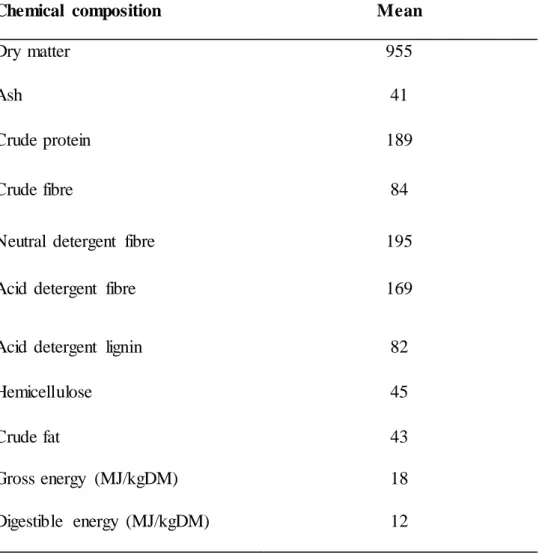
Influence of leaf meal on broiler performance
- Growth performance
- Carcass traits
- Organ weights
Challenges of using leaf meals
- Presence of thorns
- High content of fibre
- Polyphenolic compounds
- Adaptation of broilers fed on leaf meals
Polyphenolic compounds in Vachellia tortilis reduce feed intake, nutrient digestibility and absorption of nutrients (Ndou et al., 2015). Polyphenolic compounds reduce the crypt depth, intestinal wall thickness and increase the secretion of mucus in the intestinal tract. Changes in the morphology of the duodenum and colon imply changes in the digestive and absorptive capacity of the intestines (Svihus, 2014).
2015) also reported that the presence of leaf meal affects the developmental capacity and volume of intestinal segments. 2016) reported that leafy meals increase the height of villi in the intestine and reduce the presence of bacteria. Moringa oleifera leaf meal contains high amounts of short-chain carbohydrates and glycosides, which increase the height of jejunal villi (Nkukwana et al., 2015).
Summary
The extreme intestinal effort to push digestion along the digestive tract can be reflected by the thickening of the muscle layer of the duodenum and colon with increasing levels of leaf meal (Ncube et al., 2017). The thickening of the mucosal layer along the digestive tract suggests a stronger movement that forces digestion transport. Svihu (2014) reported that the jejunum muscle layer decreases in thickness with the addition of leaf meal, but the explanation is still unclear.
Decrease in thickness of the jejunum may be due to faster rate of digestive movement. The increase in height of villi in the intestine affects feed utilization efficiency during the early stages of chicken life (Nkukwana, 2012). The broad objective of the study was to determine the response to incremental levels of Vachellia tortilis leaf meal on carcass yield organ weights and gut morphology of broilers.
Performance of broilers fed on mature Moringa oleifera leaf meal as a protein supplement to soybean meal. Growth, blood chemistry and carcass yield of broilers fed cassava leaf meal (Manihot esculenta Crantz). Nutritional status, growth performance and carcass characteristics of Nguni steers supplemented with Acacia karroo leaf meal.
Effect of Moringa oleifera leaf meal on growth performance, apparent digestibility, digestive organ size and carcass yield of broilers. Performance and economic characteristics of broilers fed different dietary levels of neem (Azadirachta indica) leaf meal. Response of broilers to diets containing different amounts of Leucaena (Leucaena leucocephala) leaf meal.
Response in internal organ weights to Vachellia tortilis inclusion in
Introduction
Chicken meat provides high-quality proteins and a high concentration of polyunsaturated fatty acids (Wapi et al., 2013). Therefore, the consumption of corn and soybeans creates serious competition between poultry and humans (Halimani et al., 2005). Among other challenges, consumption of Vachellia leaf meal is likely limited by the presence of polyphenolic compounds, thorns and high fiber content (Khanyile et al., 2014).
These compounds damage the inner mucosa, which consequently impairs nutrient absorption in the intestine (Jansmanet et al., 1993). Polyphenolic compounds, especially proanthocyanidins, form insoluble complexes with divalent ions, reducing their bioavailability in the bird (Stukelj et al., 2010). The anatomy and weight of internal organs can therefore change in response to dietary tannins and fiber content (Agyekum et al., 2012).
Materials and methods
- Description of study site
- Leaf meal collection
- Experimental diets and design
- Chemical composition of feeds
- Management of birds
- Measurements of growth
- Measurements of carcass yield
- Weights of internal organs
- Statistical analyses
It is critical that leaf meal intake levels do not limit feed intake. The aim of the study was therefore to determine the response in carcass yield and organ weights of broilers fed Vachellia tortilis. Weekly feed intake (WFI) for birds was determined as the difference between the weight of feed offered at the beginning and the feed remaining in the troughs at the end of the week.
Weighing of the birds was done using an electric scale and the following variables were calculated. DP was estimated by dividing DCW by SW and expressed as a percentage. Scored organs were determined by dividing organ weight by SW and expressed as a percentage.
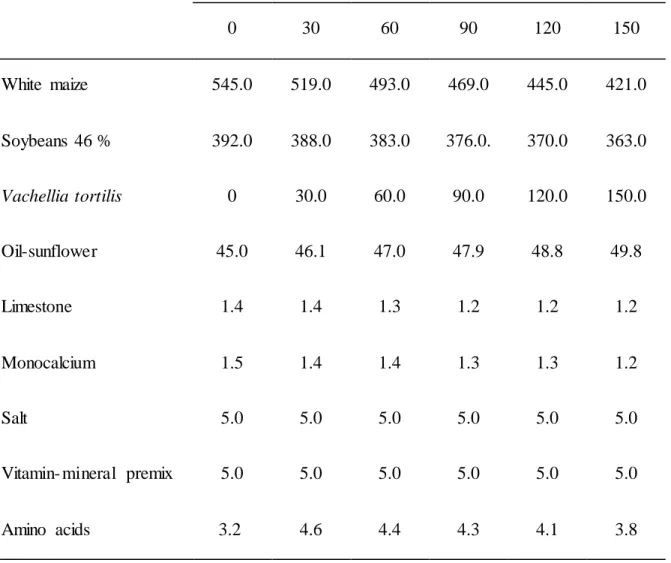
Results
- Influence of leaf meal inclusion on carcass yield
- Response in organ weights to leaf meal inclusion
Relationships between Vachellia tortilis leaf meal inclusion and performance trait ics, carcass yield and organ weights were determined with the response surface regression (RSREG) procedure of (SAS, 2009). There was no relationship in relative breast weight, TW and DW (P>0.05) to leaf meal inclusion. There was a linear decrease in SW (P<0.001) and dressed carcass weight (P<0.05) with increasing levels of leaf meal.
The relative organ weight, including intestine, gizzard, heart, kidney and proventriculus was related to increasing inclusion levels of V. The heart weight increases linearly (P<0.05) with increasing leaf meal levels with the R2 value being 0.96. However, the relative weight of the liver was not related to Vachellia tortilis inclusion (P>0.05).

Discussion
The reduction in body weight may be due to the different nutritional content of leaf meal in the meal. The linear decrease of DCW with increasing level of inclusion of Vachellia tortilis in the diet agrees with Ncube et al. 2018), who also reported a reduction in carcass weight of broilers fed increasing amounts of Vachellia angustissima leaf meal. Hetland and Svihus (2001) reported that the degree of inclusion of leaf meal affects the stimulation of gastric activity and increases gastric volume when added to the diet.
Increasing the level of incorporation of this leaf meal resulted in an increase in proventriculus weight of 0.0008 g for each increase in Vachellia tortilis levels. Caecal enlargement of broilers would increase digestive capacity relative to dietary leaf meal. It was found that the presence of leaf meal in the diet of broilers increases the length and weight of the intestinal segments and induces physical adaptation.
Conclusions
The increase in the length of the duodenum, jejunum and ileum is in accordance with previous studies (Wu et al., 2004), which reported that the inclusion of plant material in the diet increased the length of intestinal sections. The increase in intestinal length can be attributed to the long-term presence of fiber in the intestines. Thus, the inclusion of Vachellia tortilis leaf meal in the diet of broilers improved the intestinal morphology of the jejunum for the birds and contributed to better digestion and absorption of nutrients.
Performance, nutrient utilization and organ characteristics of broilers fed cassava leaf meal (Manihot esculenta Crantz). Nutritive value of Acacia species and response of pigs fed increasing levels of Acacia tortilis leaf meal-based diets. Influence of Acacia tortilis leaf meal-based diet on serum biochemistry, carcass characteristics and internal organs of fattening pigs.
Intestinal morphology, digestive organ size and digestive pH in broilers fed diets supplemented with or without Moringa oleifera leaf meal. Serum lipid, enzyme and hematological responses of broilers fed Acacia angustiss ima leaf meal-based diets. The effect of increasing levels of dried leaves of sweet potato (Ipomoea batatas) on dry matter intake and body weight gain in broilers.
Response in gut morphology to Vachellia tortilis leaf meal inclusion in
- Introduction
- Materials and methods
- Study site
- Leaf meal collection
- Experimental diets and design
- Chemical composition of feeds
- Management of birds
- Intestinal histomorphometry
- Statistical analysis
- Results
- Intestinal histomorphotry
- Discussion
- Conclusions
- References
The findings in the current study are in agreement with the findings of Nkukwana et al. 2015) who reported the effect of moringa leaf meal inclusion on jejunum villi height. Changes in the mucosa of the gastrointestinal tract with the inclusion of leaf meal may be a physiological adaptation of broilers to dietary changes. This may account for the greatest jejunal surface area observed at high levels of leaf meal incorporation.
The current study demonstrated a linear response between the ratio of villus height to crypt depth with increasing levels of V. The ratio of villus height to crypt depth decreased at a decreasing rate of 1.96 g for each g/kg increase in V. tortilis ingestion with an R2 value of 0.39. The increase in intestinal wall size was accompanied by increasing levels of Vachellia tortilis, which increases the digestibility of bulk leaf meal in the diet. This means that epithelium may have been activated due to the presence of leaf meal in the diet.
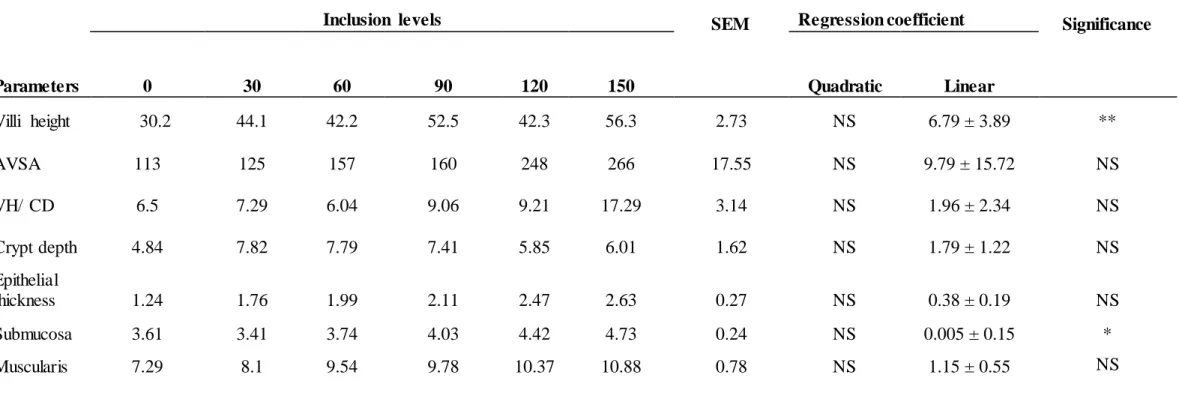
General Discussion, Conclusions and Recomme ndations
General discussion
The increase in viscera weights with increasing levels of leaf meal suggests that broilers had developed organs adapted to the inclusion of leaf meal in the diet. Stomach enlargement observed with increasing amounts of leaf meal can be explained by the compression and bulking effect of fiber, which caused an increase in size as an adaptation mechanism. The increase in heart weight was attributed to the increased blood flow and oxygenation associated with the lean carcass, as evidenced by a decrease in carcass yield traits with increasing amounts of leaf meal.
Small intestinal histomorphology was determined in Chapter 4 to test the hypothesis that increasing levels of V. Measurement of epithelial, submucosa, and muscle thickness in the jejunum of broilers on V tortilis diets was expected to vary with the level of leaf meal inclusion. The increase in intestinal volume was therefore a physiological adaptation to establish the function for increasing the volume of food in relation to leaf meal-based formulations.
Conclusions
Recommendations and further research
Ethical Approval of Research Project on Animals
